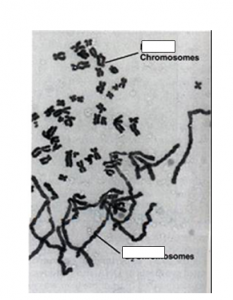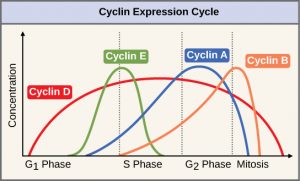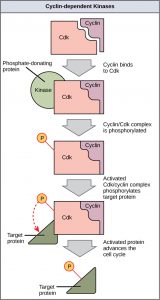Overview Video for eukaryotic cell cycle: This gives some basics on the overall process of cell reproduction and is visually striking
Cell Division Video
Objective: Know what happens in each stage of the cell cycle including each stage of mitosis Be Able to recognize cells at each stage.
Match the images to the stages!
This activity was made by a former student Athraa Kamil as a “Miss One, Make One” activity
Here is a video on mitosis with embedded questions
Objective: Be able to determine the mitotic index of cells
Objective: Be able to determine cell cycle stage lengths from data about stage distribution
Example. The total length of the cell cycle for a onion root tip cell is 30 hours. You find 120 cells in interphase, 30 in prophase, 15 in metaphase 25, in anaphase, and 15 in telophase or cytokinesis. What is the mitotic index? What is the length of prophase?
The mitotic index is the percent of total cells in mitosis. In this case, there are 200 total cells and 80 are in the stages of mitosis, so the mitotic index is 80/200=.4
To determine the length of a particular stage first determine the fraction of cells in that stage. In this case 30/200 or 15% of the cells are in prophase. We assume that the proportion of cells in a particular stage is directly related to the length of that stage (the more cells at a particular stage, the longer that stage must be. If the total cell cycle is 20 hours and 15% are in prophase, then 15% X 30=4.5 hours.
Objective: Be able to order the steps of the cell cycle and mitosis
Be able to label chromosomes including sister chromatids, centromeres and the kinetechores

Objective Be able to distinguish sister chromatids from homologues

For a given chromosome, every individual has one homologue from each of their parents A and a are different alleles (different versions of the same gene; brown and blue eyes for example)
Objective: Know the role of the following in the cell cycle: Centromere, Kinetochore, Centriole, Centrosome, Spindle, Contractile Ring
Note that centromere, centrosome and centriole all sound alike and are easy to confuse. Only the centromere is directly associated with chromosomes.
The centromere is the structure at which 2 sisters are attached. It is also attached to the Kinetochore which links the spindle to the chromosome.
Here is a useful slideshow on chromosome structure
Centrioles are barrel shaped structures from which microtubules grow. The centrosome contains the centrioles and some other components which help form microtubules

Plants do not typically contain centrioles, but they do contain centrosomes with This appears sufficient to form spindles
Objective: Be able to list cell cycle checkpoints and determine the effects of defects in cell cycle checkpoints
This animation will help you understand the basic checkpoints:
Objective: Be able to predict what happens when cells from different phases are fused together. Explain the results of fusion of interphase and M cells with respect to cyclin and MPF
Start by looking at this image

In this experiment cells from G1 phase are fused with cells from M phase
The cells from M phase (at top) have gone through S, therefore they have sisters.
The cells from G1 phase have not gone through S, do they have not replicated.
They have just started to condense. You can see them (not typical of G1 chromosomes) but they are not as condensed as the ones above.
Objective distinguish the roles of cyclin and CDKs in promoting the cell cycle
Objective be able to interpret the cell fusion events in terms the functions of cylcin and CDK
Based on these results, researchers hypothesized the presence of a factor that induced M phase. Years of genetic and biochemical research showed that this something is a factor called cyclin. Cyclin is a protein that accumulates at particular cell cycle stages and then are destroyed. Different cyclins trigger different stages.

Cyclin B is responsible for mitosis

The key here is that cyclin by itself does not cause M phase. Instead, it activates an enzyme called CDK. CDK stands for cell division Kinase. A kinase is an enzyme that adds phosphate. When CDK adds phosphates to chromosomes, they condense. This enzyme is also responsible for other prophase events like formation of a spindle and breakdown of the nuclear membrane.